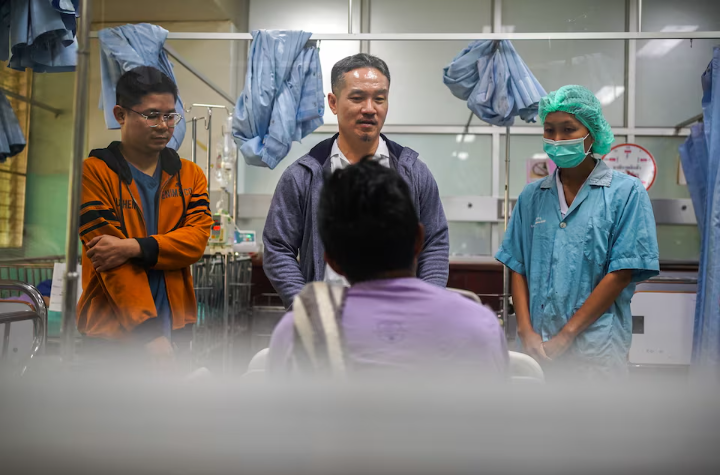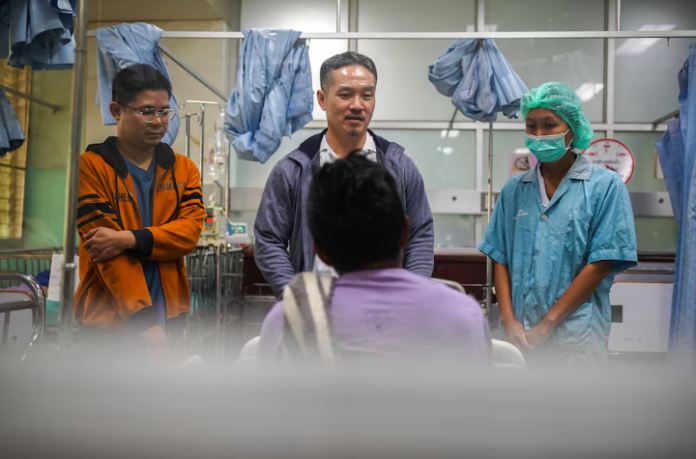In the quiet halls of Tha Song Yang Hospital in northwestern Thailand, the cries of desperate families echo louder than ever. Adabi, an 86-year-old Myanmar refugee battling heart disease and pneumonia, lies on a hospital bed, her daughter Lay Nge watching helplessly. This heart-wrenching scene has become all too common following the abrupt halt of U.S. foreign aid, leaving thousands of refugees like Adabi stranded without essential healthcare.
For years, U.S. aid funded vital healthcare services for tens of thousands of Myanmar refugees living in camps along the Thai-Myanmar border. Managed by the International Rescue Committee (IRC), these services provided a lifeline to vulnerable populations fleeing conflict and instability in Myanmar. However, a recent decision by former President Donald Trump to freeze most foreign aid has forced these facilities to shut down, leaving seriously ill refugees with no choice but to seek help from already overburdened Thai government hospitals.
“The patients stopped receiving medicine and other crucial support after the IRC pulled out,” said Tawatchai Yingtaweesak, director of Tha Song Yang Hospital, where staff are working tirelessly to fill the void left by the aid cut. Refugees like Maung Lay, a 45-year-old epilepsy patient, are now forced to seek treatment at local hospitals after suffering seizures due to the lack of medical care in their camps.
In Mae La refugee camp, home to nearly 29,000 people, one IRC hospital and two clinics once provided healthcare to the community. Staffed by a small team of doctors, around 50 medical professionals, and 100 volunteers, these facilities were crucial in managing the health needs of the camp’s residents. Now, with their closure, refugees are left scrambling. In a desperate attempt to continue services, healthcare workers have set up temporary operations in makeshift spaces, such as a former school building where an 18-year-old refugee recently gave birth under dire conditions.
Despite the Thai government stepping in to manage some of these healthcare services, officials warn that the situation is unsustainable in the long term. “In the medium term, we need support with medicine and budget,” Tawatchai noted, highlighting the monthly electricity cost of 40,000 baht ($1,200) just to keep basic services running.
Kannapong Phiphatmontrikun, head of Tha Song Yang district, expressed concern over the increasing strain on local healthcare facilities. “Thai government hospitals cannot bear this burden alone in the long run,” he said, calling for financial support from international organizations and other governments. Without additional resources, the healthcare system risks collapse, potentially leaving thousands without access to life-saving treatment.

The Thai government, however, remains steadfast in its commitment to supporting the refugees. Deputy Prime Minister Anutin Charnvirakul assured that Thailand would not abandon those in need. “The Thai health system will not let anyone whom we can help die in our country,” he vowed.
Yet, with Trump hinting at the possibility of winding down the U.S. Agency for International Development (USAID), which distributes billions of dollars in humanitarian aid worldwide, the future looks bleak for refugees dependent on this support.
Hospitals along the Thai-Myanmar border are already feeling the pressure. “We’re facing staff shortages, and patients are waiting longer than ever,” said Nuttagarn Chuenchom, a doctor at Mae Sot Hospital, in a widely shared Facebook post.
For refugees like Maung Lay, the uncertainty is overwhelming. “We have no idea what will happen to us,” he said. “We don’t have money to buy medicines. We will all die if there’s no medicine at the camp.”
As the world watches, the question remains: who will step up to fill the void left by the U.S. aid freeze?



